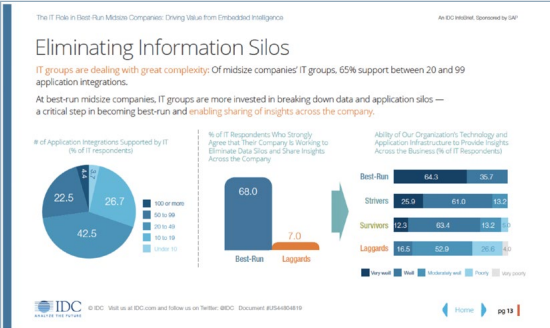
Introduction
When you think of ways to accelerate growth, developing an application integration strategy probably isn’t the first thing that comes to mind. You might think about how to improve your data sharing across marketing, sales, operations, and support or how to automate those burdensome manual processes, or how to free up your technical resources so they can work on making your product better.
Developing an integration strategy can help you do all those things and more. It might not be sexy but we’ve seen lots of companies skip or delay this step in their preparation for high growth and always regret it. They find themselves quickly overrun with data silos, disconnected processes, inconsistent customer experiences, and the need to add resources to counter the resulting operational gaps.
Why Integration Matters to Business Leaders
- 84% say integration challenges slow business process innovation
- 83% say data silos create business operations challenges
- 64% say they cannot provide a connected used experience across sales, marketing, services, and support
In the following sections, we’ll discuss how to create an integration strategy that meets your cloud data integration needs, aids growth, and minimizes technical debt. We’ll walk through evaluating different integration approaches, including pros and cons. Lastly, we’ll go through four best practices to follow when implementing an application integration platform to help free up your IT resources. We’ve gathered data from hundreds of other high growth mid-sized companies and found that with the right app integration solution and strategy in place, the stage is set for your technology to support rapid and continuous growth.
The difference between integration types
Researching integration tools can be confusing as multiple terms are used interchangeably to describe integration. Before we get further, let’s set some context and properly define these terms and how they are related.
Application Integration
Application Integration is the process of bringing resources from one application to another and often uses middleware. In most modern organizations, this generally means connecting multiple cloud apps together. This can also be referred to as Cloud Data Integration. In organizations where legacy systems exist, application integration also includes connecting on-premise and cloud apps. The applications addressed are typically core applications like ERP, CRM or e-commerce platforms where many business processes rely on data from other cloud-based apps.
Who uses these solutions:
- Cloud application integration solutions are typically tailored towards a tech-savvy business user or IT staff, but don’t usually require specialized skills.
- On-premise application integration solutions are typically tailored towards large enterprise use cases and used by IT staff with specialized skills.
Data Integration
Data Integration is a combination of technical and business processes used to combine data from disparate sources into meaningful and valuable information. Data integration goes beyond simply moving data from point a to point b by doing things to the data to make it more usable. Legacy data integration platforms are traditionally thought of as on-premise middleware solutions. They are often referred to as ETL solutions, meaning they extract, transform, and load data to another system. Modern cloud data integration solutions follow the same concepts as on-premise data integration tools but, obviously, are used for integrating cloud apps or cloud to on-premise applications.
Who uses these solutions:
Cloud application integration solutions are typically tailored towards a tech-savvy business user or IT staff, but don’t usually require specialized skills.
On-premise application integration solutions are typically tailored towards large enterprise use cases and used by IT staff with specialized skills.
Integration Platform as a Service (iPaaS)
Integration Platform as a Service (iPaaS) is a modern application integration solution that borrows key data integration concepts. iPaaS allows you to not only integrate multiple applications but manipulate, augment, and validate data quality as data is being moved. You can think of iPaaS as the offspring of app integration and data integration parents. If deployed on-premise, they follow the more traditional models of enterprise application integration (EAI) or ETL tools.
Who uses these solutions:
- iPaaS platforms can be tailored to both tech-savvy business users and IT staff. This is dependant on the complexity of the use cases the platform supports and if the solution is cloud-native vs. an on-premise solution running in the cloud.
- In general, relatively straight-forward uses cases can be accomplished by tech-savvy business users as most iPaaS solutions provide guided configuration options. For more complex use cases, typically IT or DevOps staff are implementing the solution.
API Integration
API Integration allows two applications to talk to each other through software called an Application Programming Interface (API). APIs power most modern applications and enable others to develop interfaces to those applications. For example, if you buy something on Amazon using your phone, you’re using an API. In the context of app integration, APIs enable the integrations to happen. Most application integration tools and iPaaS solutions provide an abstracted view of an application’s API by offering pre-built connectors or adapters and some level of API management. API integration platforms allow you to work with the APIs natively, and offer tools to make it easier and faster to build integrations. They also typically have more robust API management capabilities necessary for those building APIs for others to use.
Who uses these solutions:
- API integration platforms are built for and used by developers.
Contact Us for more information on getting your operations ready for the holiday with Celigo for your Business.
Copyright © 2025 - Custom Software Solutions, Inc.







